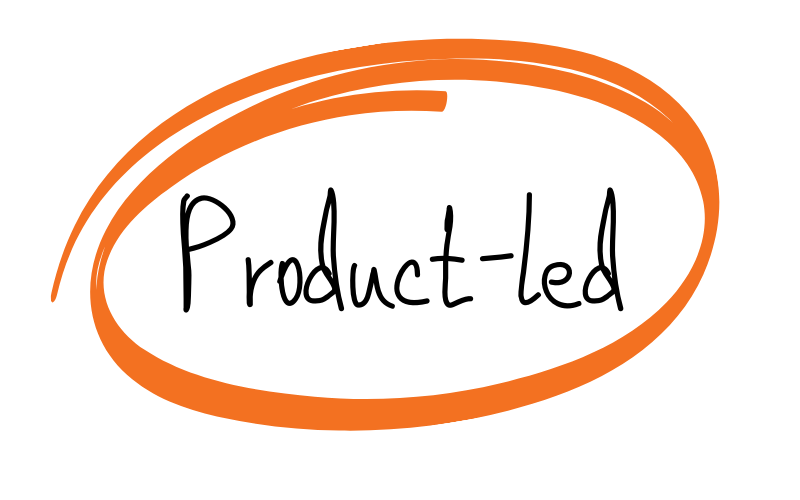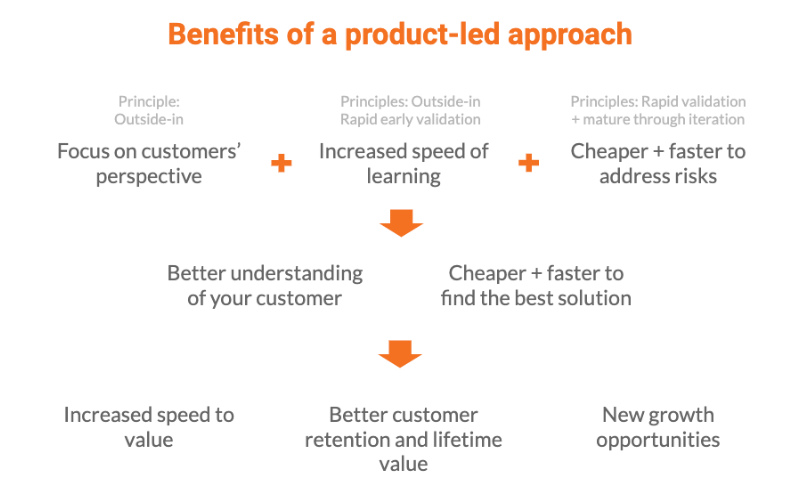
Some of us in product take it for granted that a product-led approach is the way to operate. However, all too often our stakeholders – sales, marketing, our boss’s boss, even our own team – may need some convincing.
This post provides an outline of the case for why you might take a product-led approach. In making the case, we’ll explore the reasons for and against and the alternatives. But let’s start with a quick definition before we get into detail.
What is a product-led approach?
A product-led approach, in the technology and digital context, is where your product experience is the central focus of your organisation. It’s where your organisation aims to deliver on your value proposition to your customers solely or primarily through your product(s).
Traditionally websites and web applications were essentially marketing collateral, supporting a primary person-based channel (e.g. in-store, on the phone). That is, customers bought, interacted and experienced an organisation’s offerings through the organisation’s people – like sales staff and customer support.
Today websites and apps often are the product for many organisations. Customers primarily buy, interact and experience an organisation through their digital channels. And if digital isn’t the primary channel then it is usually a significant part of the customer’s journey.
A product-led approach emerged from highly successful companies that had no option but to be product-led because their product was all they had. Out of necessity, companies like Google and Facebook, had to take an approach that led to world-leading products. They recognised that their customer’s experience of their product was at the centre of their success.
The principles of the product-led approach taken by Google and others can be summarised as:
- Take an outside-in perspective
- Rapid, early validation of ideas
- Mature through iteration
- Disciplined prioritisation
So, why take a product-led approach?
There are a few key reasons for taking a product-led approach.
You’ve already been exposed to the first and probably the most significant. If your websites, apps and (maybe) devices – your products – are or have become the channel or the primary channel through which your customers interact with your company then you have a strong driver for being product-led.
This doesn’t need to be the whole of the company. It may be in a part of your company, a division or a team.
Being or becoming product-led, taking an approach like the one outlined above, brings with it some benefits. The best way to explain these is by mapping these benefits out:

Why not take a product-led approach?
So now that we’ve seen why you might take a product-led approach, it’s worth considering why you wouldn’t.
The first and easiest reason to use to rule out taking a product-led approach is if your customer’s experience and interactions with your company are not primarily through your product or your value proposition is only partly fulfilled through your product.
Here are some examples:
- Your customer primarily interacts with you in-store.
- Your customer primarily interacts with you through a sales person
- You view your product/service as a commodity where marketing provides the differentiation
- A person ultimately provides your service
And here is an outline of some alternatives (but by no means comprehensive or complete):
- A sales-led approach: your organisation is led by what sales needs.
- A marketing-led approach: your organisation uses marketing (say branding or positioning) to deliver on your value proposition.
- A service-led approach: your organisation leads with the service provided by your people.
- An asset-led approach: your organisation’s approach is characterised by the assets it manages or deploys.
You still might determine that some parts of the experience (and your organisation) benefits from a product-led approach while others take another approach.
It can be challenging when different approaches come into play because you will often need to consider the end-to-end experience across multiple touch points to provide the best experience. There isn’t an easy answer here.
Some additional thoughts
Below are a few somewhat random additional thoughts related to why you (or your stakeholders) might benefit from a product-led approach:
- What about an agile approach? Start with what your customer needs then work out the best delivery/way of working. It will probably be agile, but agile is just one part of the overall picture especially when being product-led. Teams and whole companies can miss the forest from the trees by making agile the silver bullet.
- Need more ammunition? Gartner says CIOs must shape their digital innovation through a fundamental shift to a product-centric organization.
- Often an organisation will be a mix. In this case, you can use some of the thinking here to begin a discussion which will hopefully lead to better collaboration.

Scott Middleton
CEO & Founder
Scott has been involved in the launch and growth of 61+ products and has published over 120 articles and videos that have been viewed over 120,000 times. Terem’s product development and strategy arm, builds and takes clients tech products to market, while the joint venture arm focuses on building tech spinouts in partnership with market leaders.
Twitter: @scottmiddleton
LinkedIn: linkedin.com/in/scottmiddleton